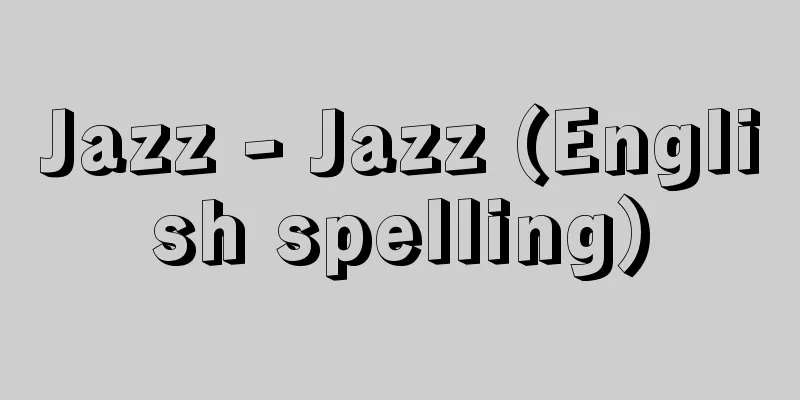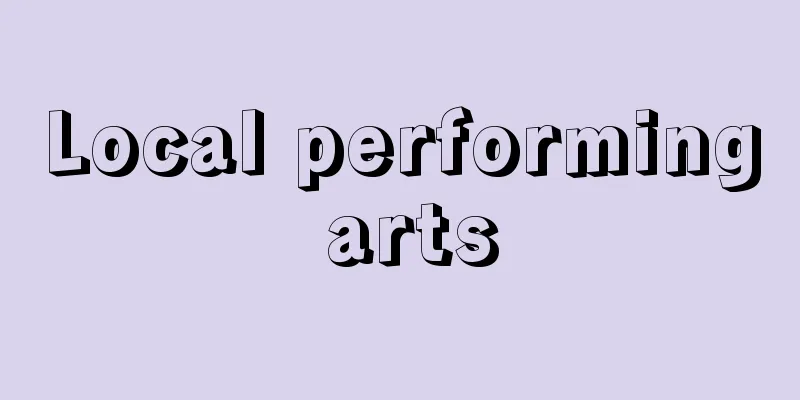Jazz - Jazz (English spelling)

|
A type of American music. It developed from parade marching music by African-American brass bands to dance music and then to music for appreciation, and today it is one of the most important genres of global popular music. Jazz was born from black brass bands in New Orleans, Louisiana, in the early 20th century as a fusion of African-American folk music and white European music. Its rhythm, phrasing, sound, and blue note (a unique mode in which the third and seventh degrees are lowered by a semitone) were born from the influence of African-American folk music and the unique musical sensibility of African-Americans, while the instruments used, melodies, and harmonies follow the traditions of European music. Its characteristics include (1) a sense of swing that comes from the off-beat (also called after-beat) rhythm, which places the accent on the second and fourth beats of the 4/4 time signature, (2) free creativity and vitality demonstrated in improvisation, and (3) sound and phrasing that strongly express the individuality of the performer. These are said to be fundamental differences between European music and classical music. [Aoki Kei November 19, 2018] The origin of jazzThere are various theories about the origin of the word, but it is not certain. One theory is that it comes from the old British word jass, which means "lewd," another is that it comes from the slang word jazz, which was used by black people in the southern United States from the 19th century to mean sexual acts, or to mean enthusiasm or fast tempo and rhythm, and another is that it is a corruption of the name of a drummer named Charles, which became Chas, Jass, and Jazz. The meaning of the word jass has changed in various ways, and in the 1910s in Chicago it became a slang word meaning "comfortable" or "good mood." It is also unclear when black music with the above characteristics began to be called jazz. Jelly Roll Morton (1890-1941), a famous jazz pianist and composer, is said to have named his piano playing style jazz in 1902, and later called himself the founder of jazz, but no one believed him. Before it was called jazz, it was called ragtime music or just rag, due to a confusion with ragtime, the black piano music that was also very popular in band performances. There is a record that in 1916, a white group active in Chicago called "Stein's Band from Dixie" took a hint from the word jass and renamed themselves "Stein's Dixie Jass Band", and from then on the genre came to be called jazz. This group further renamed themselves "The Original Dixieland Jazz Band" and recorded the first jazz record in history in January 1917, but the label of that record was printed with "jass band", while the label of the record recorded the following February was printed with "jazz band", showing that spelling was not consistent at the time. [Aoki Kei November 19, 2018] The mother of jazzIt was in 1619 that black people began to be imported into America in earnest as labor, that is, as slaves. Imports became more frequent every year. They were brought in via Central and South America, with the West Indies being a particular stopover. White people banned and took away all of the African customs, including religion, held by the black slaves. However, black people expressed the traditional characteristics of African music in various forms. The first musical expressions were shouts and hollers, both of which mean "to shout," and were short words sung in a shouting manner with a sliding pitch. It was a simple and rustic musical expression of their emotions. Next came work songs, sung while working on farms or on railroads. This gave rise to the response or alternating singing style. There were also chain gang songs, which were work songs for prisoners. Eventually, influenced by European music such as Christian hymns and incorporating the unique sensibilities of black people, black spirituals were created and became widely popular. After the Civil War (1861-1865) ended with the victory of the Union Army, which advocated the emancipation of black slaves, freed black people began to live their own lives. Songs were born in the South that expressed the joys and sorrows of their private lives in simple forms. These were the blues. After the emancipation of slaves, more black people made a living as entertainers and musicians, but most of them were active in popular entertainment such as minstrel shows and vaudeville. In the mid-1890s, a rhythmic style of piano music called ragtime was created and became popular among black pianists working in saloons and clubs in Missouri. Like classical music, this style is performed according to the score and does not allow for improvisation. In that sense, it is not jazz, but it also became one of the foundations of jazz. At that time, black brass bands became popular in New Orleans, Louisiana. This port city was also a musical town, and it is said that this was because black people were able to obtain cheap instruments from Confederate military bands that had lost the Civil War. Black brass bands were active in celebratory parades and funeral marches, and their marches also became one of the origins of jazz. [Aoki Kei November 19, 2018] historyThe Birth of JazzBlack brass bands in New Orleans were organized by amateurs and imitated white bands, playing European dances, marches, hymns, and spirituals. Many of the band members could not read music, but were taught by Creoles (people of mixed race, mainly Spanish or French), who were treated equally to whites until the abolition of slavery. Black band members learned and assimilated white music and European techniques through Creoles, not through the direct influence of whites. Black bands were influenced by shouts, hurlers, work songs, and other elements, and began to show a unique black rhythm in the performance of ragtime and marches. Black bands began to instrumentalize the blues, and some even improvised and deformed the original songs. Trumpeter Buddy Bolden (1877-1931) was a representative example of this, and became a legendary figure. Furthermore, around the beginning of the 20th century, collective improvisation by a trio of trumpets, trombones, and clarinets supported by a rhythm section and the style of ensemble progression became a major feature. In this way, jazz was born from black brass bands. [Aoki Kei November 19, 2018] Early style and evolutionThe earliest style was mainly marching tempo, with wind instruments improvising and intertwining the melody to create a contrapuntal effect. This style, characterized by collective improvisation and ensemble, is called New Orleans jazz. Jazz performed by white people in this style is called Dixieland jazz, but today the distinction is often not made and it is generally called Dixieland jazz. Dixie is a slang term for the southern states of the United States. Black jazz musicians in New Orleans primarily worked in Storyville, a red-light district lined with brothels, and in the surrounding clubs and cabarets. In the 1910s, young white men who were fascinated by their performances began to study and play jazz. In November 1917, during World War I, the port of New Orleans became a naval port, and Storyville was closed by order of the Secretary of the Navy. Jazz musicians who lost their jobs then migrated to cities in the North and Midwest, such as Chicago, New York, Memphis, and Kansas City, Missouri, in search of new venues for their activities, which led to the spread and development of jazz across the United States. [Aoki Kei November 19, 2018] Chicago and New York in the 1920sMany excellent black jazz musicians gathered in Chicago, and following the cornet virtuoso King Oliver (1885-1938), his student Louis Armstrong also came to Chicago in 1922. Louis changed the traditional jazz style, which was centered on ensembles, to solo jazz, and showed a new direction for jazz that continues to this day. Some young white men in Chicago also aspired to be jazz musicians, and they added white sensibility, feeling, and sophistication to New Orleans jazz, creating a unique style. This was later called the Chicago style. White jazz musicians in Chicago include Benny Goodman, Gene Krupa, guitar and banjo player Eddie Condon (1905-1973), and saxophonist Bud Freeman (1906-1991). In addition to black jazz musicians, they were also influenced by the white jazz musician Bix Beiderbecke (1903-1931). Bix was a gifted cornet player who created white jazz with his unique playing style and became a central figure among white jazz musicians in Chicago. In the 1920s, blues performances on the piano developed into boogie woogie in Chicago's black neighborhoods. Boogie woogie was started by black piano player Jimmy Yancy (1894/1898-1951), and the style was perfected by Clarence Smith (1904-1929), known by the nickname "Pinetop." In the 1920s, New York saw the remarkable development of jazz performed by large orchestras, i.e., big band jazz. Fletcher Henderson (1897-1952) and Duke Ellington, who were active in the clubs and ballrooms of the black residential area of Harlem, created a sound and style with unique arrangements. Although these big bands had to perform music for dances, they incorporated the spirit and idiom of jazz into their music, and made people aware of the appeal of jazz. A new piano style also emerged in Harlem. The African-American James P. Johnson (1894-1955) created a style based on ragtime piano playing, in which the left hand plays the bass beat in octaves by "straddling" it, known as the "stride piano." This style had a strong influence on Duke Ellington, Fats Waller (1904-1943), Earl Hines (1903-1983), and many other pianists. [Aoki Kei November 19, 2018] Swing JazzThe popularity and development of big band jazz in New York eventually promoted the development of jazz as a whole. During the long depression that began with the Wall Street Crash in October 1929, sweet and sentimental popular music was popular, but in 1935, when signs of economic recovery appeared, big band jazz called swing music by the Benny Goodman Orchestra exploded in popularity. Their performances, mainly using Fletcher Henderson's famous arrangements, had a crisp and clear swing feel and a sophisticated and smart charm typical of white people, and the public welcomed swing music as music different from black jazz, a bright and healthy new music by white people, and they were enthusiastic about it. Following Goodman, white big bands such as Glenn Miller, Tommy Dorsey (1905-1956), Artie Shaw (1910-2004), and Bob Crosby (1913-1993) gained popularity, and this led to a boom in swing jazz and the emergence of the swing era. Then, combo jazz, small bands made up of members picked up from big bands and temporary small bands for recording jazz, also became popular. As the recognition that solos are the core of jazz deepened, this reflected a trend to enjoy swing not only as dance music but also as appreciation music. Although white bands were the driving force behind the swing era, black bands also gradually gained popularity. One black band that attracted attention was the Count Basie Orchestra. Successor to the Benny Moten Orchestra, which had been active since the 1920s in Kansas City, Missouri, the band displayed the unique appeal of Kansas City jazz, with its blues spirit, relaxed atmosphere, arrangements made through simple meetings (head arrangements), and ensembles featuring improvised riffs (repeated short musical phrases). The Basie Orchestra made a big splash when it moved to New York in 1936. Each orchestra had its own singer, and it was also an era of band singers competing for popularity. [Aoki Kei November 19, 2018] The development of modern jazzEven into the 1940s, swing jazz, centered around big bands, remained popular with a wide range of people, but when the United States entered World War II in 1941, band members were called up for military service, which made it difficult for bands to operate, and their performances became stale, and swing bands began to decline. Ambitious young jazz musicians began experimenting with new jazz styles at jam sessions at New York clubs such as Minton's Playhouse. A new jazz style called be-bop (also called bop) was created and stylized by guitarist Charlie Christian, drummer Kenny Clarke (1914-1985), Charlie Parker, Dizzy Gillespie, and others. Be-bop differs from traditional jazz in that it reforms the three elements of melody, harmony, and rhythm, and its performance has a strong expression, with rapid tempo and leaps in sound that can be described as eccentric. It was stylized around 1944 and was heavily criticized at the time, but it soon gained widespread support and became the basis of modern jazz. In other words, jazz based on the techniques of be-bop is collectively called modern jazz. Big bands such as the band of singer Billy Eckstine (1914-1993), who introduced bebop techniques, and the Woody Herman Band, also became popular, and furthermore, the Stan Kenton Band, which demonstrated a white sensibility using modern musical techniques, attracted attention, and the big bands also became more modern. Towards the end of the 1940s, reflecting the sense of life entering a period of stability after the chaos of World War II, and in contrast to the strong stimulation of bebop, Miles Davis, Stan Getz, Gil Evans and others created a style of jazz with a restrained, cool sound and a good balance of solos and ensembles, which had assimilated the ideas and methods of bebop. This was called cool jazz. Furthermore, pianist Lennie Tristano and his student, alto saxophonist Lee Konitz, created a cool style of jazz with intellectual, introspective beauty. In the 1950s, a new style of jazz by white musicians emerged in Los Angeles, California on the West Coast. It began with the city's military boom caused by the Korean War that broke out in 1950, and Hollywood movie companies placing importance on soundtrack recordings and seeking musicians with strong musical scores, which attracted many talented white jazz musicians from the Woody Herman and Stan Kenton bands. The jazz of trumpeter Shorty Rogers (1924-1994), baritone saxophonist and pianist Gerry Mulligan, and drummer Shelly Manne (1920-1984) was cool but had a light and dynamic feel, a bright charm of a sophisticated white sensibility, and the delicate sound of the arrangements and the harmony of the solos gave it a fresh and interesting group expression. This is called West coast jazz. Meanwhile, black jazz musicians on the East Coast, such as those in New York, made a comeback in the mid-1950s, overwhelming the stagnant West Coast movement. They took back the initiative in jazz from whites with combo jazz based on improvised ad-lib solos, a mature form of be-bop, and with vital expression of black emotion or funky performance with a strong black flavor. This is called East coast jazz, and is also known as hard bop. Representative figures include trumpeters Miles Davis and Clifford Brown, drummers Art Blakey and Max Roach, pianist and composer Horace Silver, tenor saxophonist Sonny Rollins, and bassist, pianist and composer Charles Mingus. We also cannot forget the Modern Jazz Quartet (MJQ) of pianist and composer John Lewis (1920-2001), who brought a unique style to intellectual, chamber music-style jazz. [Aoki Kei November 19, 2018] Avant-garde jazz and crossoverAt the end of the 1950s, hard bop also began to reach a dead end. Then black alto saxophonist Ornette Coleman appeared, who rejected the existing concept of jazz and devoted himself to free improvisation, free from the constraints of chord progressions, bars and tonality, establishing the foundations of avant-garde jazz and free jazz. Miles Davis also experimented with jazz using modes (modes or series of notes), expanding the possibilities of improvisation. The 1960s could be described as a tumultuous era for jazz, marked by free jazz and modal jazz. Ornette's collaboration with trumpeter Don Cherry sparked controversy, while John Coltrane, who explored modes, was influenced by Ornette and created his own new style, influencing many jazz musicians. Pianist Cecil Taylor studied European music and Afro-American traditions, and became one of the pioneers of avant-garde new jazz with his radical, atonal improvisations. Saxophonist Albert Ayler, known for his free and intense colors, is also not to be missed. This new jazz found sympathizers in Europe and Japan, and new developments were seen. At the end of the 1960s, Miles introduced rock rhythms and electric sounds, and released the LP album "Bitches Brew." This is considered to have hinted at the jazz of the 1970s. Jazz became even more diverse, and pianist Joe Zawinul and saxophonist Wayne Shorter, both from Miles' group, formed Weather Report, and Chick Corea formed Return to Forever, which appealed to a wide range of people and gained popularity with their new style of music that fused various elements such as rock, black soul music, and Latin. This style was called crossover or fusion, and reached its peak in the 1970s, when diversification and the development of electric instruments progressed. On the other hand, there was a rediscovery of acoustic sounds, a revival of hard bop, and new activities by jazzmen influenced by free jazz, and these must also be recorded as part of the state of jazz in the 1970s. [Aoki Kei November 19, 2018] 1980s and afterIn the summer of 1980, 18-year-old trumpeter Wynton Marsalis from New Orleans joined Art Blakey's band and attracted attention. After leaving the band in 1982, he gained popularity and fame for his diverse activities that brought jazz traditions to life with his excellent techniques and ideas. Young musicians like Wynton, such as his brother saxophonist Branford Marsalis (1960- ) and trumpeter Roy Hargrove (1969-2018), have emerged as the new traditionalists. Meanwhile, keyboardist Herbie Hancock, who also played in Miles' band in the 1960s, created his own fusion music using synthesizers and vocoders (a device that electronically mixes and processes human voices and instruments). In 1983, he led the Rock-It band and released the album Future Shock, which introduced hip-hop, which was just starting to become popular at the time, and it became an explosive hit. In 1983, pianist Keith Jarrett formed a trio with bassist Gary Peacock (1935-2020) and drummer Jack DeJohnette (1942- ), to play classic standards, and their performances were well-received both in Japan and abroad. Since 2000, the trio has also been performing free improvisations of original songs. Since the 1990s, a number of talented young jazz musicians have emerged and are making remarkable achievements. The album features the keenly-sensational alto saxophonist Chris Potter (1971-), the tenor and alto saxophonist Joshua Redman (1969-), who is creative not only in traditional performances but also in playing with complex time signatures, the pianist Brad Mehldau (1970-), who uses a variety of techniques to show the subtlety of composition and development, as well as the fresh charm of lyricism and romanticism, the Cuban-born Latin jazz pianist Gonzalo Rubalcaba (1963-), the trumpeter Dave Douglas (1963-) and the New Orleans-born Nicholas Payton (1973-), the organist Joey DeFrancesco (1971-), and the female composer and arranger Maria Schneider, who leads a big band. Schneider (1960- ) is a representative figure of the 1990s. Jazz, which was born in the United States in the early 20th century, is still a living music, a music of the times, and continues to be created and develop while reflecting the changes of the times. [Aoki Kei] Jazz VocalsJazz vocals are music performed with instruments, that is, singing with the human voice, applying the characteristics of jazz, which is instrumental music. The conditions for jazz singing, which is modeled on jazz, are feeling, a sense of swing rhythm, improvisational ad-lib that shows creativity, and phrasing. Strictly speaking, since instrumental music and vocal music cannot be considered the same, it should be called jazz vocals, but it is generally called jazz vocals, and singers who are committed to this singing style are called jazz singers. [Aoki Kei November 19, 2018] The beginnings of jazz vocalsJazz vocals began with trumpeter Louis Armstrong. His singing was instrumental, transferring the phrases of his trumpet playing directly to the human voice, and he would freely improvise the original melody (and sometimes the lyrics) if necessary to make the song swing. Louis had a raspy voice and broke the traditional condition of a singer being a beautiful and trained voice, and in February 1926, he recorded the first record in history to include scat (improvisational singing with meaningless sounds instead of lyrics) with the song "Heebie-Jeebies". Influenced by Louis, Bing Crosby and Mildred Bailey (1907-1951) became pioneers of white jazz singers in the late 1920s, and in 1933, the genius Billie Holiday, the greatest jazz singer, made her first recording and attracted attention. Then came Ella Fitzgerald. In 1942, during World War II, Frank Sinatra, a talented jazz singer, left the Tommy Dorsey Orchestra and gained widespread popularity. [Aoki Kei November 19, 2018] Modern Jazz VocalsIn the mid-1940s, the bebop technique was introduced into jazz vocals, and modern jazz vocals were born, founded by Billy Eckstine (1914-1993) and his student Sarah Vaughn. Since then, modern singers such as Mel Torme, Anita O'Day, Carmen McRae, June Christy (1925-1990), Chris Connor (1927-2009), and Betty Carter (1930-1998) have been active. In 1952, the Four Freshmen, a modern jazz chorus using open harmony in which the top part sings the melody, attracted widespread attention, and King Pleasure (1922-1982) and Eddie Jefferson (1918-1979), who sang lyrics to famous jazz performances recorded on records, became a hot topic. This technique is called vocalise, and a record by the trio Lambert, Hendricks & Ross, who completed the technique with a chorus, became a huge hit in 1958. In the 1960s, artists who used their voices in an avant-garde jazz style, such as Sheila Jordan (1928-), Jeanne Lee (1939-2000), and Karin Krog (1937-), as well as Nina Simone (1933-2003), who showed an African orientation and a total musicality, and Nancy Wilson (1937-2018), whose core was jazz and rhythm and blues, attracted attention. In the 1970s, Dee Dee Bridgewater (1950-), who straddled both jazz and fusion, Al Jarreau, the chorus group Manhattan Transfer, and Flora Purim (1942-) from Brazil became popular. Jazz singers who have been active since the 1980s include the passionately individualistic young Diane Schuur (1953-), Cassandra Wilson, Bobby McFerrin (1950-), who uses his voice as an instrument, Kurt Elling (1967-), and Canadian Diana Krall (1964-). [Aoki Kei] Japanese JazzDawnIn the mid-1910s (from the end of the Meiji period to the early Taisho period), Japanese performers from the Pacific Passenger Ship Orchestra learned about new dance music, such as ragtime music and fox trot, which were popular in the United States, and began to try to perform them. The leader, violinist Hatano Fukutaro (1890-1974), left the ship in 1918 (Taisho 7) and formed the Hatano Orchestra, accompanied silent films at cinemas in Tokyo, and became popular for performing popular American songs during breaks. In the 1920s, dance became popular, and dance hall members in Tokyo and Kansai researched jazz on their own as records. In 1923, violinist Ida Ichiro (1894-1972) formed the first professional jazz band in Japan. In 1928, Futamura Teiichi (1900-1948) sang "My Blue Sky" and "Arabian Songs" sung by Futamura Teiichi (1900-1948), became a huge hit, and since then, jazz songs that sang popular American songs in Japanese, mainly with jazz bands as accompaniment. At that time, student jazz bands such as Watanabe Yoshi (1903-1976) from Hosei University and Kikuchi Shigeya (1903-1976) from Keio University were also active. Talky films have also been screened in Japan since 1929, and records for film theme songs have also been released, making jazz and American popular music even more familiar. In 1934, trumpet player Nanri Fumio formed Hot Peppers and became popular, and Dick Minne (1908-1991) sung by Dick Mine (1908-1991) was a hit. In 1936, jazz singer Sanae Mizushima (1909-1978) returned to Shanghai (Shanghai). In the end of the 1930s, swing jazz flourished in dance halls and theaters, but in October 1940, dance halls all over the country were closed, and the start of the war in Japan in December 1941, Japan's jazz career was interrupted. [Aoki Kei November 19, 2018] After World War IIThe war ended in August 1945, and in September of that year, Matsumoto Shin (1908-1978)'s New Pacific Orchestra began. The following year, in June 1946, Watanabe Hiroshi (1912-1988)'s Stardusters were established. In this way, many jazzmen, mainly prewar factions, opened up a new path to Japanese jazz while learning about be-bop and other things. The Jean Crupa Trio, who came to Japan in 1952, also had a big influence. In 1953, the unprecedented jazz boom, and the Big Four, George Kawaguchi (1927-2003), Matsumoto Hidehiko (1926-2000), Nakamura Hachidai, and Ono Mitsuru (1929-2008), became representative popular groups. Although it was lost to rock and roll since the end of the 1950s, in the late 1960s, young elite young players such as saxophone Sadao, trumpet Hino Komasa, and piano player Yamashita Yosuke emerged, creating jazz that is highly regarded internationally. Piano Akiyoshi Toshiko, who has been active in the United States since 1965, formed an orchestra in the same area in 1974, and became a global leader in writing, arrangement and conductor. In the 1980s, dynamic and fresh piano player Ozone Makoto (1961-), and Maruyama Shigeo (1951-), who also composed and arranged music and arranged music, and was also the leader of the Suiguruza Orchestra. In addition, alto saxophonist MALTA (real name, Yoshiaki, 1949-), who was a member of the American Lionel Hampton Orchestra, became a star in jazz and fusion. Many large-scale newcomers appeared in the 1990s. In particular, the large-scale piano player Onishi Junko (1967-), trumpet player Hara Tomonao (1966-), tenor saxophonist Kawashima Tetsuro (1966-), drum player Osaka Masahiko (1966-), piano player and composer Fujii Satoko, who is also avant-garde and leader of big bands, are talented people who are widely known internationally, and are a huge power in the advancement and new developments of Japanese jazz. [Aoki Kei] になったんです。 English: The first thing you can do is to find the best one to do .になったんです。 English: The first thing you can do "Introduction to Women's Jazz Vocals" (2000, Matsuzaka)" ▽ "Murao Rikuo's Complete Collection of Jazz Poetry" 20 volumes, separate volume 2 (1991-2010, Chuo Art Publishing)" ▽ "Uchida Koichi, Japanese Jazz History - Pre-World Post-War (1976, Swing Journal Publishing)" ▽ "Segawa Masahisa, Dance with Jazz - History of Imported Music and Entertainment (1983, Simul Publishing)" ▽ "Jazz Whirlwind - Early War Legends of Post-War Era" (1997, Sanichi Shobo)" ▽ "Okunari Tatsuo, Everyone Who Was Lived in Jazz - Private Edition - History of Japanese Jazz" (1997, Sanichi Shobo)" [References]Source: Shogakukan Encyclopedia Nipponica About Encyclopedia Nipponica Information | Legend |
|
アメリカ音楽の一種類。黒人(アフリカ系アメリカ人)のブラスバンド(吹奏楽)によるパレードの行進音楽からダンス音楽、そして鑑賞のための音楽へと発展し、今日では世界的なポピュラー音楽としてもっとも重要な一分野となっている。 ジャズは、アメリカの黒人の民俗音楽と白人のヨーロッパ音楽との融合によって20世紀の初めごろ、ルイジアナ州ニュー・オーリンズの黒人ブラスバンドから生まれた。そのリズム、フレージング、サウンド、ブルー・ノートblue note(第3度と第7度の音が半音下がった独特の旋法)はアフリカ系民俗音楽の影響とアメリカ黒人独特の音楽感覚とから生まれ、使用楽器、メロディ、ハーモニーはヨーロッパ音楽の伝統に準じている。 また、その特徴としては、(1)4分の4拍子の第2拍と第4拍にアクセントを置くオフ・ビート(アフター・ビートともいう)のリズムから生じるスウィング感、(2)インプロビゼーション(即興演奏)に示される自由な創造性と活力、(3)演奏者の個性を強く表出するサウンドとフレージング、以上の3点があげられ、これらがヨーロッパ音楽またはクラシック音楽との根本的な違いであるといえる。 [青木 啓 2018年11月19日] ジャズの語源語源については諸説あるが、確定することはできない。「卑猥(ひわい)な意味をもつ」というイギリスの古語ジャスjassによるとする説、19世紀からアメリカ南部の黒人が使っていた性行為などの性的意味や、熱狂とか、急速なテンポやリズムを意味するスラングのジャズjazzによるとする説、チャールズというドラム奏者の名がCharles→Chas→Jass→Jazzと転訛(てんか)したとする説などがある。jassということばの意味はさまざまに変化し、1910年代のシカゴでは「快適」とか「ごきげん」といった意味のスラングになっていた。前記のような特色をもつ黒人音楽をジャズと称するようになった時期も明らかではない。名ジャズ・ピアニストで作曲家のジェリー・ロール・モートンJelly Roll Morton(1890―1941)は、1902年に自分のピアノ演奏スタイルをジャズと名づけたといい、後年にジャズの創始者と自称したが、信じる人はいなかった。ジャズと称される以前は、楽団演奏でも大流行した黒人のピアノ音楽ラグタイムragtimeと混同された形でラグタイム・ミュージック、またはラグとよばれていた。 1916年にシカゴで活動していた白人グループ「ディキシーからきたスタインのバンド」が、jassということばにヒントを得て「スタインのディキシーjassバンド」と改名し、これからジャズと称されるようになった、という記録がある。このグループはさらに「オリジナル・ディキシーランド・ジャズ・バンド」と改名、1917年1月に史上最初のジャズ・レコードを録音したが、そのレコードのラベルにはjass bandと印刷され、続く2月録音のレコードのラベルにはjazz bandと印刷されており、当時はスペリングが一定していなかったことがわかる。 [青木 啓 2018年11月19日] ジャズの母体アメリカにアフリカから黒人が労働力、つまり奴隷として本格的に輸入され始めたのは1619年である。輸入は年ごとに盛んになった。中南米を経て運び込まれたもので、とくに西インド諸島が中継地となっていた。白人は、奴隷である黒人のもっていたアフリカの慣習を、宗教も含めていっさい禁止し、奪った。だが黒人は、アフリカの伝統的音楽特性をさまざまな形で表出した。その最初の音楽的表現はシャウトshoutおよびハラーhollerであり、ともに「叫ぶ」という意味をもち、短いことばで音程を滑らせながら叫ぶように歌う。それは彼らの感情の単純素朴な音楽表現であった。 次に現れたのはワーク・ソングwork song(労働歌)で、農園とか鉄道などの作業時に歌われる。ここに応答形式、あるいは交互歌唱形式が生まれた。囚人のワーク・ソングとしてのチェイン・ギャング・ソングchain gang song(鎖でつながれた囚人の歌)もある。やがてキリスト教の賛美歌をはじめとするヨーロッパ音楽の影響を受けて、黒人独特の感覚で融合しながらブラック・スピリチュアルblack spiritual(黒人霊歌)がつくられ、広く普及した。 南北戦争(1861~1865)が黒人奴隷解放を主張する北軍の勝利で終わったあと、解放された黒人は個人としての生活に入ったが、その私生活の哀歓を素朴な形式で率直に表現する歌が南部で生まれた。これがブルースbluesである。奴隷解放後は芸能人や音楽家として身をたてる黒人が増えたが、そのほとんどはミンストレル・ショーやボードビルなどの大衆演芸を活動の場とした。1890年代の中ごろに、ミズーリ州の酒場やクラブで働く黒人ピアニストたちの間で、ラグタイムと称するリズミックなスタイルのピアノ音楽が生まれて流行した。これは、クラシック音楽と同様に、楽譜どおりに演奏するものであって即興性はない。その点からジャズではないのであるが、これまたジャズの母体の一つになった。 そのころルイジアナ州ニュー・オーリンズでは、黒人によるブラスバンドが盛んになった。港のあるこの町は音楽の盛んな町でもあったが、南北戦争に敗れた南軍軍楽隊の楽器を黒人たちが安価で入手できたためという。黒人ブラスバンドの活躍の場は祝祭パレードや葬送行進で、その行進曲もジャズの母体の一つになっている。 [青木 啓 2018年11月19日] 歴史ジャズの誕生ニュー・オーリンズの黒人ブラスバンドはアマチュアの人々によって編成され、白人のバンドをまねてヨーロッパの舞曲や行進曲、賛美歌、黒人霊歌などを演奏した。楽譜の読めない人も多いバンドの指導をしたのはクレオール(黒人と白人の混血人、おもにスペイン人かフランス人との混血)であって、クレオールは奴隷解放までは白人と同等に扱われた。黒人バンドの人々は、白人の直接の影響ではなく、クレオールを通じて白人の音楽やヨーロッパの手法を学び、消化したのである。黒人バンドにはシャウトやハラー、ワーク・ソングなどの感覚が入り込み、ラグタイム曲や行進曲の演奏に黒人独特のリズム感をみせ始め、歌曲であるブルースを器楽化するようになり、原曲を即興的に崩して演奏する者も出現した。トランペット奏者バディ・ボールデンBuddy Bolden(1877―1931)はその代表的な一人で、伝説的な人物となっている。さらに20世紀初めごろ、リズム・セクションに支えられたトランペット、トロンボーン、クラリネットの三管編成によるコレクティブ・インプロビゼーションcollective improvisation(集団即興演奏)とそのアンサンブル進行のスタイルが大きな特色として形成された。こうして黒人ブラスバンドからジャズが誕生した。 [青木 啓 2018年11月19日] 初期のスタイルと変遷もっとも初期のスタイルは、おもに行進するテンポで、管楽器がメロディを即興的に崩しながら絡み合い、対位法的効果を生むものであった。その集団即興演奏とアンサンブルに特色のあるスタイルを、ニューオーリンズ・ジャズNew Orleans jazzと称する。このスタイルによって白人が演奏するジャズをディキシーランド・ジャズDixieland jazzと称するが、今日では区別しないことが多く、一般にディキシーランド・ジャズとよばれている。ディキシーとはアメリカ南部諸州をさす俗称である。 ニュー・オーリンズの黒人ジャズメンは、娼家(しょうか)の並ぶ紅灯街ストーリービルstoryvilleとその周辺のクラブやキャバレーなどを主要な仕事場としていた。1910年代になると、彼らの演奏に魅せられて学び、ジャズを演奏する白人青年も現れた。第一次世界大戦中の1917年11月、ニュー・オーリンズの港は海軍の軍港になり、海軍長官の命令でストーリービルは閉鎖された。そこで、職場を失ったジャズメンはシカゴ、ニューヨーク、メンフィス、ミズーリ州のカンザス・シティなど北部や中西部の都会に新しい活動の場を求めて移住し、これがジャズの全米的な普及と発展につながった。 [青木 啓 2018年11月19日] 1920年代のシカゴとニューヨーク優秀な黒人ジャズメンが多く集まったのはシカゴで、コルネットの名手キング・オリバーKing Oliver(1885―1938)に続いて、1922年には彼の弟子であるルイ・アームストロングもシカゴに進出して活躍。ルイは、アンサンブル中心であった従来のジャズを、ソロ中心のジャズに変え、今日につながるジャズの新方向を示した。シカゴの白人青年たちの間にもジャズを志す者が現れ、ニューオーリンズ・ジャズに白人の感覚とフィーリング、洗練度を加えて演奏し、独特のスタイルをつくった。これがのちにシカゴ・スタイルChicago styleとよばれたものである。シカゴの白人ジャズメンには、ベニー・グッドマン、ジーン・クルーパ、ギター・バンジョー奏者のエディ・コンドンEddie Condon(1905―1973)、サックス奏者のバド・フリーマンBud Freeman(1906―1991)らがいる。彼らは黒人ジャズメンのほかに、白人ビックス・バイダーベックBix Beiderbecke(1903―1931)からも影響を受けた。ビックスは天才的なコルネット奏者で、独自の感覚による演奏で白人ジャズを創造し、シカゴの白人ジャズメンの中心人物となった。なおシカゴの黒人街で1920年代に、ピアノによるブルース演奏がブギ・ウギboogie woogieとして発展した。ブギ・ウギは黒人ピアノ奏者ジミー・ヤンシーJimmy Yancy(1894/1898―1951)が始め、「パイン・トップ」の愛称で知られるクラレンス・スミスClarence Smith(1904―1929)がそのスタイルを完成させたという。 1920年代のニューヨークでは大編成楽団によるジャズ、つまりビッグ・バンド・ジャズの発展が目覚ましい。黒人居住地区ハーレムのクラブやボールルーム(ダンスホール)で活躍するフレッチャー・ヘンダーソンFletcher Henderson(1897―1952)やデューク・エリントンらは、独特の編曲によるサウンドとスタイルを創造している。これらのビッグ・バンドはダンスのための音楽として演奏しなければならなかったが、そのなかにジャズの精神と語法を盛り込み、人々にジャズの魅力を知らしめた。またハーレムから新しいピアノ・スタイルも生まれている。黒人ジェームズ・P・ジョンソンJames P. Johnson(1894―1955)はラグタイム・ピアノ奏法をもとに、左手でベース・ビートをオクターブに「大またでまたぐ」ように弾くスタイル、つまりストライド・ピアノstride pianoというスタイルを生み、デューク・エリントン、ファッツ・ウォーラーFats Waller(1904―1943)、アール・ハインズEarl Hines(1903―1983)ほか多くのピアニストに強い影響を与えた。 [青木 啓 2018年11月19日] スウィング・ジャズニューヨークにおけるビッグ・バンド・ジャズの流行と発展は、やがて、ジャズ全体の進展を促すことになった。1929年10月のウォール街(株式)大暴落に始まった長い不況の間は、甘美で感傷的なポピュラー・ミュージックが流行したが、景気回復の兆しがみえた1935年、ベニー・グッドマン楽団のスウィング・ミュージックと称するビッグ・バンド・ジャズが爆発的な人気をよんだ。主としてフレッチャー・ヘンダーソンの名編曲を用いた演奏は、歯切れのよい明快なスウィング感、白人らしい洗練されたスマートな魅力があり、大衆は、スウィング・ミュージックを、黒人のジャズとは違う音楽、白人による明るくて健全な新しい音楽として大歓迎し、熱狂した。グッドマンを追って、グレン・ミラー、トミー・ドーシーTommy Dorsey(1905―1956)、アーティ・ショーArtie Shaw(1910―2004)、ボブ・クロスビーBob Crosby(1913―1993)らの白人ビッグ・バンドが人気を博し、ここにスウィング・ジャズswing jazzのブームがおき、スウィング時代が現出した。そして、ビッグ・バンドからのピックアップ・メンバーによる小編成楽団(コンボ)、およびレコード吹き込みのための臨時の小編成楽団のジャズ演奏、コンボ・ジャズcombo jazzも盛んに行われるようになる。ソロこそジャズの核であるとの認識が深まったため、スウィングをダンス音楽としてのみならず、鑑賞音楽として楽しもうという傾向を反映したものといえる。 スウィング時代の立役者は白人バンドであったが、黒人バンドも徐々に人気を高めた。注目された黒人バンドの一つにカウント・ベイシー楽団がある。中部ミズーリ州のカンザス・シティで1920年代から活躍していたベニー・モーテン楽団の後身で、ブルース精神とリラックスした気分、簡単な打合せによる編曲(ヘッド・アレンジ)、即興的なリフ(短い楽句の繰り返し)のアンサンブルなど、カンザス・シティ・ジャズ独特の魅力を発揮する。ベイシー楽団は1936年のニューヨーク進出で大評判になった。なお各楽団には専属の歌手がおり、それぞれに人気を競い合うバンド・シンガーの時代でもあった。 [青木 啓 2018年11月19日] モダン・ジャズの展開1940年代に入ってもビッグ・バンドを中心とするスウィング・ジャズは幅広い大衆に親しまれたが、1941年にアメリカが第二次世界大戦に参戦すると、楽団員の軍隊応召などの影響で楽団運営は苦しくなり、演奏のマンネリ化もみられ、スウィング・バンドの衰退が始まる。 意欲的な若手ジャズメンはニューヨークのクラブ「ミントンズ・プレイハウス」などでのジャム・セッションにおいて、新しいジャズの実験的な試みを始めた。ギター奏者のチャーリー・クリスチャン、ドラム奏者のケニー・クラークKenny Clarke(1914―1985)をはじめ、チャーリー・パーカー、ディジー・ガレスピーらによってビ・バップbe-bop(単にバップとも称する)という新しい理念のジャズが創造され、スタイル化された。ビ・バップは従来のジャズと異なり、メロディ、ハーモニー、リズムの3要素が改革され、その演奏の表情は強烈で、急速なテンポ、音の飛躍などはエキセントリックともいえる。スタイル化されたのは1944年ごろで、当時はかなりの非難も浴びたが、やがて広く支持されるようになり、モダン・ジャズmodern jazzの母体となる。つまり、ビ・バップの手法に基づくジャズをモダン・ジャズと総称しているのである。ビ・バップ手法を導入した歌手ビリー・エクスタインBilly Eckstine(1914―1993)の楽団、ウッディ・ハーマン楽団などのビッグ・バンドも人気をよび、さらに近代音楽的な手法で白人感覚を示すスタン・ケントン楽団が注目され、ビッグ・バンドのモダン化も進んだ。 1940年代の終わりに近く、第二次世界大戦後の混乱から安定期に入った生活感覚を反映し、またビ・バップの強い刺激感に対して、ビ・バップの理念と手法を消化したうえでの抑制された冷ややかな感じのサウンド、ソロとアンサンブルのバランスのとれたスタイルのジャズが、マイルス・デービス、スタン・ゲッツ、ギル・エバンズらによって生まれ、クール・ジャズcool jazzとよばれた。さらにピアノ奏者レニー・トリスターノとその門下生のアルト・サックス奏者リー・コニッツらが、理知的な内省美をもつクール・スタイルのジャズを創造している。 1950年代になると、西海岸のカリフォルニア州ロサンゼルスで白人による新しいジャズ・スタイルがおこった。1950年に勃発(ぼっぱつ)した朝鮮戦争による同市の軍需景気と、ハリウッドの映画会社がサウンドトラック録音を重視して譜面に強いミュージシャンを求めたために、ウッディ・ハーマン楽団やスタン・ケントン楽団出身の優秀な白人ジャズメンが多数集まったことに始まる。トランペット奏者ショーティ・ロジャーズShorty Rogers(1924―1994)、バリトンサックス・ピアノ奏者ジェリー・マリガン、ドラム奏者シェリー・マンShelly Manne(1920―1984)らのジャズは、クールではあっても軽快な躍動感をもち、白人的な洗練された感覚の明るい魅力があり、編曲によるデリケートなサウンドとソロの調和にグループ表現としての新鮮なおもしろさがあった。これがウェスト・コースト・ジャズWest coast jazzとよばれるものである。 一方、ニューヨークなど東海岸の黒人ジャズメンは、1950年代なかばから、行き詰まってきたウェスト・コースト派を圧倒する巻き返しをみせた。ビ・バップを成熟させた形の即興アドリブ・ソロを主体とするコンボ・ジャズで、黒人的情感のバイタルな表現、あるいは黒人的なにおいを強く感じさせるファンキーな演奏で、ジャズの主導権を白人から奪回した。これをイースト・コースト・ジャズEast coast jazzとよび、ハード・バップhard bopという別称もある。その代表的人物は、トランペットのマイルス・デービス、クリフォード・ブラウン、ドラムのアート・ブレーキー、マックス・ローチ、ピアノ奏者・作曲家のホレス・シルバー、テナー・サックスのソニー・ロリンズ、ベースおよびピアノ奏者・作曲家チャールズ・ミンガスらである。知的で室内楽的なジャズにユニークな個性を示したピアノ奏者・作曲家ジョン・ルイスJohn Lewis(1920―2001)のモダン・ジャズ・カルテット(MJQ)の存在も忘れられない。 [青木 啓 2018年11月19日] 前衛ジャズとクロスオーバー1950年代末にはハード・バップにも行き詰まりが感じられ始めた。そこに登場したのが黒人アルト・サックス奏者オーネット・コールマンで、彼は既成のジャズ概念を否定し、コード進行と小節および調性の制約から脱して自由な即興演奏に徹し、前衛ジャズ、フリー・ジャズfree jazzの基盤を確立した。またマイルス・デービスはモードmode(旋法または音列)によるジャズを試み、アドリブの可能性を広げた。 1960年代はフリー・ジャズとモード・ジャズ(モーダル・ジャズmodal jazz)によるジャズの激動時代といえる。オーネットはトランペット奏者ドン・チェリーと組んだ活動で賛否の論争を巻き起こし、モードを探究したジョン・コルトレーンはオーネットの影響も受けて独自の新スタイルをつくりだし、多くのジャズメンに影響を与えた。ピアノ奏者セシル・テーラーはヨーロッパ音楽とアフロ・アメリカの伝統を研究し、過激で無調的な即興演奏によって前衛ニュー・ジャズの先駆者の一人となった。自由で強烈な色彩感のあるサックス奏者アルバート・アイラーも見逃せない。こうしたニュー・ジャズはヨーロッパや日本にも共鳴者を生み、新たな展開がみられた。 1960年代末にマイルスはロックのリズムとエレクトリック・サウンドを導入し、LPアルバム「ビッチェズ・ブリュー」を発表。これは1970年代ジャズを示唆したものと評価されている。ジャズはさらに多様化し、マイルス・グループ出身のピアノ奏者ジョー・ザビヌルとサックス奏者ウェイン・ショーターはウェザー・リポート、チック・コリアはリターン・トゥ・フォーエバーというグループを結成、ロックや黒人のソウル・ミュージック、ラテンなど、さまざまな要素を融合した新手法の音楽で幅広い層にアピールし、人気を得た。このようなスタイルはクロスオーバーcrossoverまたはフュージョンfusionとよばれ、多様化と電化楽器の発展が進んだ1970年代に全盛をみた。その一方では、アコースティック・サウンドの再認識、ハード・バップのリバイバル、フリー・ジャズの洗礼を受けたジャズメンの新感覚による活動などもあり、これらも1970年代ジャズの状況として記録されねばなるまい。 [青木 啓 2018年11月19日] 1980年代以降1980年の夏、ニュー・オーリンズ出身で当時18歳のトランペット奏者ウィントン・マルサリスがアート・ブレーキーのバンドに参加して注目された。彼は1982年にバンドから独立後、優れたテクニックとアイデアで、ジャズの伝統を今日に生かす多彩な活動を展開して高い人気と名声を得た。彼の兄であるサックス奏者のブランフォード・マルサリスBranford Marsalis(1960― )やトランペット奏者ロイ・ハーグローブRoy Hargrove(1969―2018)など、ウィントンと同志の若手が台頭、彼らは新伝承派とよばれる。 一方、1960年代にマイルスのバンドにも参加したキーボード奏者のハービー・ハンコックは、シンセサイザーやボコーダー(人の声と楽器音などを電子的に混合、加工する装置)などを駆使して独自のフュージョンを創造したが、1983年にロックイット・バンドを率いて当時流行し始めていたヒップ・ホップを導入したアルバム『フューチャー・ショック』を発表し、爆発的なヒットとなった。この1983年にピアノ奏者キース・ジャレットはベース奏者ゲイリー・ピーコックGary Peacock(1935―2020)、ドラム奏者ジャック・ディジョネットJack DeJohnette(1942― )とスタンダード名曲を演奏するトリオを結成、内外の演奏で大好評を博した。トリオは2000年からオリジナル曲によるフリーの即興演奏も行っている。 1990年代以降、若手逸材ジャズメンの出現が相次ぎ、その活躍が目覚ましい。鋭い感性のアルト・サックス奏者クリス・ポッターChris Potter(1971― )、オーソドックスな演奏のみならず、複雑な変拍子を使った演奏にも創意を発揮するテナーおよびアルト・サックス奏者ジョシュア・レッドマンJoshua Redman(1969― )、さまざまな技法を用いた演奏で構成と展開の妙、叙情美とロマンティシズムの新鮮な魅力をみせるピアノ奏者ブラッド・メルドーBrad Mehldau(1970― )、キューバ出身のラテン・ジャズピアノ奏者ゴンサロ・ルバルカバGonzalo Rubalcaba(1963― )、トランペット奏者のデイブ・ダグラスDave Douglas(1963― )とニュー・オーリンズ生まれのニコラス・ペイトンNicholas Payton(1973― )、オルガン奏者ジョーイ・デフランセスコJoey DeFrancesco(1971― )、ビッグ・バンドを率いる女性作曲・編曲者マリア・シュナイダーMaria Schneider(1960― )などが1990年代の代表格といえよう。このように、20世紀初頭にアメリカで誕生したジャズは、いまなお生きている音楽、時代の音楽であり、時代の変化を反映しながら創造と発展の歩みを続けている。 [青木 啓] ジャズ・ボーカル楽器で演奏する音楽、つまり器楽であるジャズの特質を応用して人声で歌うのがジャズ・ボーカルである。フィーリング、スウィングするリズム感、創造力を示すインプロビゼーションによるアドリブ、そのフレージングなどが、ジャズを範としたジャズ唱法の条件となる。厳密には、器楽と声楽を同一視できないのでジャズ的ボーカルとすべきだが、一般にジャズ・ボーカルと称し、この唱法に徹した歌手をジャズ歌手、ジャズシンガーとよぶ。 [青木 啓 2018年11月19日] ジャズ・ボーカルの始まりジャズ・ボーカルはトランペット奏者ルイ・アームストロングから始まった。彼の歌唱は、彼のトランペット演奏のフレーズをそのまま人声に移した器楽的なもので、歌をスウィングさせるために必要とあらば原メロディを(ときには歌詞も)自由に即興でつくりかえてしまう。ルイはしわがれ声で、美声による訓練された発声という従来の歌手の条件を破り、1926年2月には『ヒービー・ジービーズ』という歌で史上初のスキャットscat(歌詞にかえて意味のない音で即興的に歌うこと)の入ったレコードを録音した。ルイの影響を受けて1920年代末にビング・クロスビーとミルドレッド・ベイリーMildred Bailey(1907―1951)が白人ジャズ歌手の草分けとなり、1933年には最高のジャズ歌手である天才ビリー・ホリデーが初録音して注目された。ついでエラ・フィッツジェラルドが出現。第二次世界大戦中の1942年には、ジャズ唱法もうまいフランク・シナトラがトミー・ドーシー楽団から独立し、幅広い人気を得た。 [青木 啓 2018年11月19日] モダン・ジャズ・ボーカル1940年代なかばにビ・バップの手法がジャズ・ボーカルに取り入れられ、ビリー・エクスタインBilly Eckstine(1914―1993)とその弟子サラ・ボーンを創始者とするモダン・ジャズ・ボーカルが誕生した。以来、メル・トーメ、アニタ・オデイ、カーメン・マクレエ、ジューン・クリスティJune Christy(1925―1990)、クリス・コナーChris Connor(1927―2009)、ベティ・カーターBetty Carter(1930―1998)らモダンな歌手が活躍。1952年には一番上のパートがメロディを歌うオープン・ハーモニーを使ったモダンなジャズ・コーラスのフォー・フレッシュメンが広く注目され、レコードに残されたジャズ名演に歌詞をつけて歌うキング・プレジャーKing Pleasure(1922―1982)やエディ・ジェファソンEddie Jefferson(1918―1979)が話題になった。この手法はボーカリーズとよばれ、これをコーラスで完成させた3人組ランバート・ヘンドリックス・アンド・ロスLambert, Hendricks & Rossのレコードが1958年に大評判となる。 1960年代には、前衛ジャズ的に声を使うシーラ・ジョーダンSheila Jordan(1928― )、ジーン・リーJeanne Lee(1939―2000)、カーリン・クローグKarin Krog(1937― )ら、アフリカ志向とトータルな音楽性を示すニーナ・シモンNina Simone(1933―2003)、ジャズとリズム・アンド・ブルースを核とするナンシー・ウィルソンNancy Wilson(1937―2018)が注目を集める。1970年代になると、ジャズとフュージョン双方にまたがるD・D・ブリッジウォーターDee Dee Bridgewater(1950― )、アル・ジャロウ、コーラス・グループのマンハッタン・トランスファーManhattan Transfer、ブラジル出身のフローラ・プリムFlora Purim(1942― )らが人気をよぶ。1980年代以降に活躍したジャズ・シンガーとしては、熱烈な個性のある若手ダイアン・シューアDiane Schuur(1953― )、カサンドラ・ウィルソン、声を楽器そのものにするボビー・マクファーリンBobby McFerrin(1950― )、カート・エリングKurt Elling(1967― )、カナダ出身のダイアナ・クラールDiana Krall(1964― )などがあげられる。 [青木 啓] 日本のジャズ黎明(れいめい)期1910年代なかば(明治末から大正初め)に太平洋航路客船の楽団の日本人演奏者たちが、アメリカで流行していたラグタイム音楽やフォックス・トロットなど新しいダンスの音楽を知り、その演奏を試み始めた。リーダーであるバイオリン奏者の波多野福太郎(1890―1974)は1918年(大正7)に船を離れてハタノ・オーケストラを結成、東京の映画館で無声映画の伴奏をつとめ、休憩時間にアメリカの流行曲も演奏して評判になった。 1920年代に入るとダンスが盛んになり、東京や関西にできたダンスホールの楽団員たちはレコードも参考にしてジャズを研究。1923年にはバイオリン奏者の井田一郎(1894―1972)が、日本最初のプロのジャズ・バンドであるラフィング・スターズを結成している。1928年(昭和3)二村定一(ふたむらていいち)(1900―1948)の歌った『私の青空』『アラビアの唄(うた)』などが大ヒットし、以後、ジャズ・バンドを伴奏に主としてアメリカのポピュラー・ソングを日本語で歌うジャズ・ソングが流行した。そのころ法政大学の渡辺良(1903―1976)、慶応義塾大学の菊地滋弥(きくちしげや)(1903―1976)らの学生ジャズ・バンドも活躍。1929年から日本でもトーキー映画が上映され、映画主題歌のレコード発売も活発となり、ジャズとアメリカのポピュラー音楽はいっそう身近になっていった。 1934年トランペット奏者の南里文雄(なんりふみお)がホット・ペッパーズを結成して人気をよび、ディック・ミネ(1908―1991)の歌う『ダイナ』がヒット。1936年にジャズ歌手の水島早苗(さなえ)(1909―1978)が上海(シャンハイ)から帰国。1930年代末にはダンスホールや劇場でスウィング・ジャズが隆盛したが、1937年からの日中戦争の影響などで1940年10月には全国のダンスホールが閉鎖され、1941年12月の日米開戦で日本のジャズの歩みは中断された。 [青木 啓 2018年11月19日] 第二次世界大戦後1945年(昭和20)8月に終戦、その年の9月には松本伸(しん)(1908―1978)のニュー・パシフィック楽団が活動開始。翌1946年6月に渡辺弘(1912―1988)のスターダスターズが発足した。こうして戦前派の人々を中心に、多くのジャズメンがビ・バップなども学びながら新しい日本のジャズの道を開いていった。1952年に来日したジーン・クルーパ・トリオの影響も大きい。1953年に空前のジャズ・ブームとなり、ジョージ川口(1927―2003)、松本英彦(ひでひこ)(1926―2000)、中村八大(はちだい)、小野満(みつる)(1929―2008)のビッグ・フォーは代表的人気グループになる。1950年代末からロックン・ロールに人気を奪われた形になったが、1960年代後半にはサックスの渡辺貞夫(さだお)、トランペットの日野皓正(てるまさ)、ピアノの山下洋輔ら若手精鋭が台頭、国際的にも高く評価されるジャズを創造し、1965年以降アメリカで活躍するピアノの秋吉敏子(としこ)は同地で1974年に楽団を結成、作・編曲・指揮者として世界的な大物となった。 1980年代に入って、ダイナミックでフレッシュなピアノ奏者小曽根真(おぞねまこと)(1961― )、作曲と編曲も手がけるジャズ歌手で酔狂座オーケストラのリーダーでもある丸山繁雄(1951― )が登場した。また、アメリカのライオネル・ハンプトン楽団のメンバーだったアルト・サックス奏者MALTA(本名・丸田良昭(よしあき)、1949― )が、ジャズとフュージョンでスターになる。1990年代には大型新人が多数出現した。とくにスケールの大きいピアノ奏者大西順子(1967― )、トランペット奏者原朋直(ともなお)(1966― )、テナー・サックス奏者川嶋哲郎(てつろう)(1966― )、ドラム奏者大坂昌彦(1966― )、前衛派でビッグ・バンドのリーダーでもあるピアノ奏者・作曲家の藤井郷子(さとこ)らは国際的にも広く知られた実力者であり、日本のジャズの前進と新たな展開の大きなパワーになっている。 [青木 啓] 『油井正一著『ジャズの歴史物語』(1972・スイング・ジャーナル社)』▽『ヨアヒム・ベーレント著、油井正一訳『ジャズ――ラグタイムからロックまで』(1975・誠文堂新光社)』▽『マーク・C・グリッドリー著、本多俊夫訳『ジャズのスタイルブック――スタイリストたちの名演に迫る』(1984・スイング・ジャーナル社)』▽『ナット・ヘントフ著、志村正雄訳『ジャズ・イズ』新装版(1991・白水社)』▽『フランク・ティロー著、中嶋恒雄訳『ジャズの歴史――その誕生からフリー・ジャズまで』(1993・音楽之友社)』▽『副島輝人著『現代ジャズの潮流』(1994・丸善)』▽『悠雅彦著『ジャズ――進化・解体・再生の歴史』(1998・音楽之友社)』▽『ラングストン・ヒューズ著、木島始訳『ジャズの本』(1998・晶文社)』▽『ロイ・カー著、広瀬真之訳『ジャズ100年史』(1999・バーン・コーポレーション)』▽『デイヴィッド・ペリー著、瀬川純子訳『ジャズ・グレイツ』(2000・アルファベータ)』▽『青木啓・海野弘著『ジャズ・スタンダード100――名曲で読むアメリカ』(新潮文庫)』▽『油井正一著・選曲『Jazz lady's vocal――CDで聞く女性ジャズ・ヴォーカリスト20人の魅力と名曲20』(1990・主婦の友社)』▽『アドリブ編・刊『女性ヴォーカル――THE EXCITING JAZZ BOOKS』(1993)』▽『岩浪洋三著『ジャズ・ヴォーカルの名唱名盤』(2000・立風書房)』▽『季刊ジャズ批評編集部編『女性ジャズ・ヴォーカル入門』(2000・松坂)』▽『村尾陸男著『ジャズ詩大全』全20巻・別巻2(1991~2010・中央アート出版社)』▽『内田晃一著『日本のジャズ史――戦前戦後』(1976・スイング・ジャーナル社)』▽『瀬川昌久著『ジャズで踊って――舶来音楽芸能史』(1983・サイマル出版会)』▽『高橋一郎・佐々木守編著『ジャズ旋風――戦後草創期伝説』(1997・三一書房)』▽『奥成達著『みんながジャズに明け暮れた――私家版・日本ジャズ史』(1997・三一書房)』 [参照項目] | | | | | | | | | | | | | | | | | | | | | | | | | | | | | | | | | | | | | | | | | | | | | | | | | | | | | | | | | | | | | | | | | | |出典 小学館 日本大百科全書(ニッポニカ)日本大百科全書(ニッポニカ)について 情報 | 凡例 |
Recommend
Ink painting - Suminuri
[1] 〘 noun 〙① = sumitsuke (sumi-tsuke) ① [Haikai, ...
Behavioral science
A general term for the scientific trend that seek...
Column (writing implement) - Karamu
...In order to make it easier for pens and brushe...
Alyangura - Alyangura
…Part of the Arnhem Land Aboriginal Area. The mai...
Institute of Marxism-Leninism
An affiliated organization of the Central Committe...
cord moss
…Hyotan-goke has been studied in detail from many...
Kandoh
...Located in the upper reaches of the Shirakawa ...
Cramer, Johann Baptist
Born: February 24, 1771, Mannheim [Died] April 16,...
Opal - opal (English spelling)
It is a type of hydrous silicate mineral, and its...
Toshitada Okada
…Hita, a tenryo established by inheriting Toyotom...
Osteogenesis imperfecta
What is the disease? There are several classifica...
Sundry Cargo (English)
…Industrial products are not bulk cargo, but indi...
Quezon (English spelling) Manuel Quezon
President of the Philippine Commonwealth. Born in...
Tsukiyamadono
Wife of Tokugawa Ieyasu. Also called Suruga Gozen...
Weatherbelt Land - Weatherbelt Land
…A Presbyterian confession of faith established i...


![Touin [town] - Touin](/upload/images/67cc4d319a5fb.webp)






